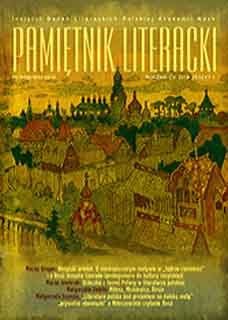Rosyjski arlekin. O nierozpoznanym motywie w „Jądrze ciemności”
Russian Harlequin. On an Unknown Motif in “Heart of Darkness” and on Joseph Conrad’s Russia (a Prolegomena to Russian Culture)
Author(s): Maciej GlogerSubject(s): Literary Texts
Published by: Instytut Badań Literackich Polskiej Akademii Nauk
Keywords: Joseph Conrad; Joseph Conrad’s “Heart of Darkness”; Gustaw Herling-Grudziński; Czesław Miłosz; Wit Tarnawski; Bogumił Jasinowski; Marian Zdziechowski; Richard Pipes; Alain Besançon; Ewa M. Thompson; figure of harlequin
Summary/Abstract: The object of the author’s interpretative investigation is the figure of harlequin in Joseph Conrad’s “Heart of Darkness” (1899). The figure’s hermeneutics is carried out in the broad contexts of Russia’s cultural anthropology and Russian history from the reign of Ivan the Terrible till modern times. Conrad’s views on Russia are also confronted with Polish 20th c. political science discussions on Russian cases (e.g. the voices by Gustaw Herling-Grudziński, Czesław Miłosz, Wit Tarnawski), Polish Sovietological school theories (Bogmił Jasinowski, Marian Zdziechowski), Western Sovietologists’ opinions (Richard Pipes, Alain Besançon), the practice of Russian colonialism (Ewa M. Thompson’s work) and others. In the light of these investigations the harlequin is seen as a prophetic symbol, a foretoken of Bolshevik anti-culture and as a metonymy of Russia as well as of the processes leading it from the czarist oppression to communist totalitarianism, and in consequence also to Vladimir Putin’s oligarchic system.
Journal: Pamiętnik Literacki. Czasopismo kwartalne poświęcone historii i krytyce literatury polskiej
- Issue Year: 2014
- Issue No: 1
- Page Range: 7-24
- Page Count: 18
- Language: Polish

